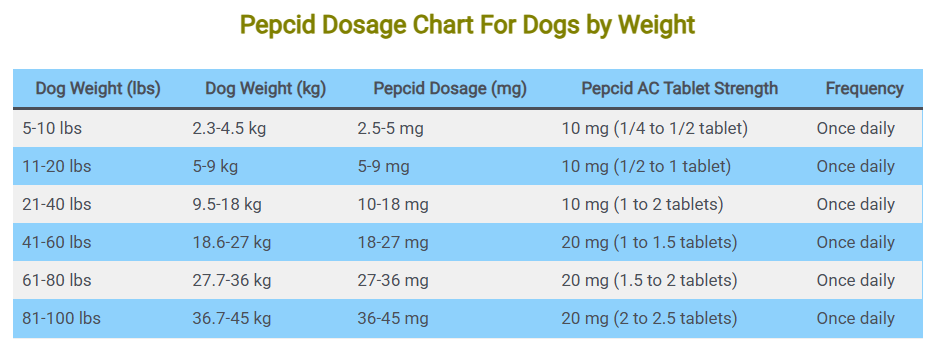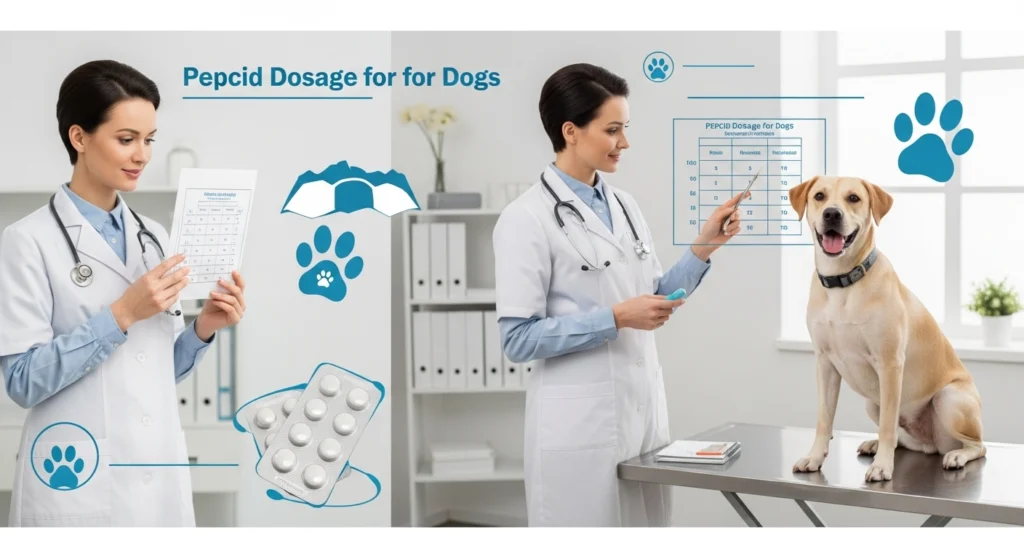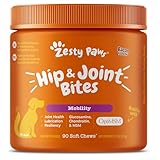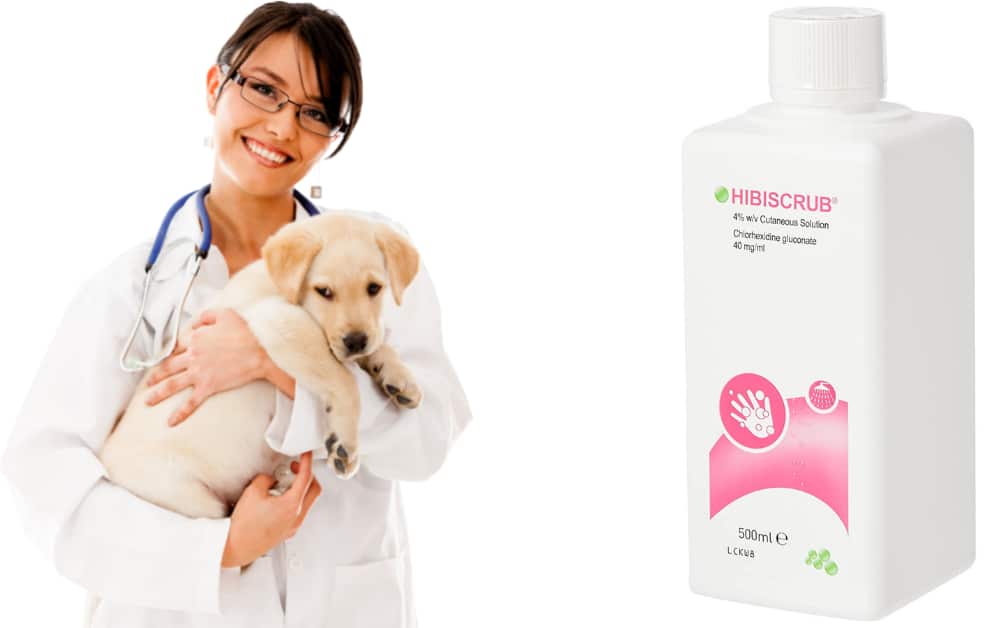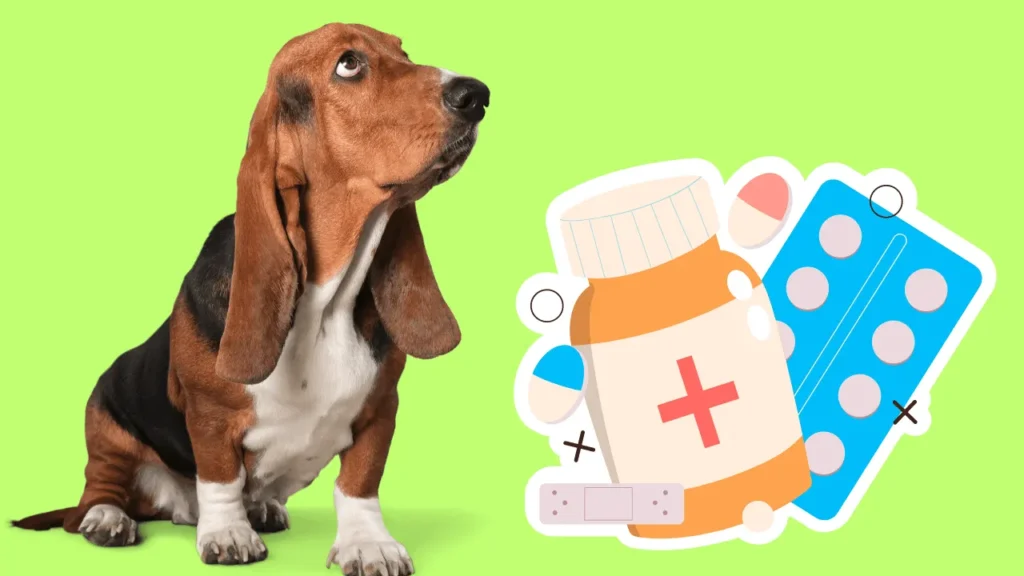Pepcid, the brand name for famotidine, is a medication that works wonders for dogs suffering from various gastrointestinal issues. This powerful yet safe medication reduces stomach acid production by blocking histamine-2 receptors in the stomach lining.
When your furry friend is dealing with uncomfortable conditions like acid reflux, stomach ulcers, or frequent vomiting, Pepcid can provide much-needed relief by creating a less acidic environment in their digestive tract.
Unlike some medications that taste bitter and cause dogs to drool or resist treatment, Pepcid is generally well-accepted by our canine companions. It’s available in multiple forms, including tablets, capsules, and oral liquid, making it easier for pet parents to administer the proper dose based on their dog’s specific needs and size.
Key Takeaways
- Famotidine (Pepcid) for dogs helps reduce stomach acid and protects the stomach lining from various gastrointestinal issues
- Always administer Pepcid under veterinary supervision, even though it’s available over-the-counter
- Proper dosage depends on your dog’s weight, typically ranging from 0.5 mg to 1 mg per kilogram every 24 hours
- Pepcid can interact with other medications, including antibiotics like Simplicef for dogs, so inform your vet about all medications your pet is taking
- Most dogs tolerate Pepcid well with minimal side effects when given at the correct dosage
When Do Veterinarians Prescribe Pepcid for Dogs?
Veterinarians may recommend Pepcid for dogs experiencing a variety of gastrointestinal problems. This versatile medication addresses several conditions that can cause your dog discomfort and potential health complications if left untreated.
Common Conditions Treated with Pepcid
- Stomach ulcers: These painful sores in the stomach lining can cause significant discomfort and may lead to more serious issues if not treated properly.
- Esophagitis or esophageal ulcers: Inflammation or ulcers in the esophagus can make swallowing painful and difficult for your dog.
- Gastric reflux: Similar to heartburn in humans, this condition occurs when stomach acid flows back into the esophagus.
- Frequent vomiting: Chronic vomiting can indicate various underlying issues, and Pepcid can help reduce the associated stomach irritation.
- Gastritis: Inflammation of the stomach lining can result from multiple causes, including dietary indiscretion.
- Toxin ingestion: When dogs consume certain toxins, Pepcid may be prescribed as part of the treatment protocol.
- Parvovirus: This serious viral infection often causes severe gastrointestinal symptoms, and Pepcid may be used as part of supportive care.
Pepcid Dosage for Dogs
Veterinarians typically recommending Pepcid dose at a range of 0.5 mg to 1 mg per kilogram of body weight every 24 hours.
Determining the correct dosage of Pepcid for your dog is crucial for both safety and effectiveness. The appropriate amount depends primarily on your dog’s weight. In some cases, your vet may suggest dividing this into two doses given every 12 hours.
Pepcid Dosage Chart For Dogs by Weight
| Dog Weight (lbs) | Dog Weight (kg) | Pepcid Dosage (mg) | Pepcid AC Tablet Strength | Frequency |
|---|---|---|---|---|
| 5-10 lbs | 2.3-4.5 kg | 2.5-5 mg | 10 mg (1/4 to 1/2 tablet) | Once daily |
| 11-20 lbs | 5-9 kg | 5-9 mg | 10 mg (1/2 to 1 tablet) | Once daily |
| 21-40 lbs | 9.5-18 kg | 10-18 mg | 10 mg (1 to 2 tablets) | Once daily |
| 41-60 lbs | 18.6-27 kg | 18-27 mg | 20 mg (1 to 1.5 tablets) | Once daily |
| 61-80 lbs | 27.7-36 kg | 27-36 mg | 20 mg (1.5 to 2 tablets) | Once daily |
| 81-100 lbs | 36.7-45 kg | 36-45 mg | 20 mg (2 to 2.5 tablets) | Once daily |
Note: This chart is a general guideline. Always follow your veterinarian’s specific dosage instructions for your dog.
Important Dosage Considerations
- Timing: Pepcid works best when given before your dog’s first meal of the day, but it can also be administered with food if that’s easier for your pet.
- Formulation: Only use plain famotidine (Pepcid) for dogs. Avoid Pepcid AC or Pepcid Complete, as these contain additional ingredients that may be harmful to dogs.
- Consistency: Try to give the medication at the same time(s) each day to maintain consistent levels in your dog’s system.
- Duration: Follow your veterinarian’s recommendations regarding how long to continue treatment, even if your dog seems to be feeling better.
How to Administer Pepcid to Your Dog
Getting your dog to take medication can sometimes be challenging, but Pepcid is generally easier to administer than many other medications due to its relatively neutral taste. Here are some effective methods to ensure your dog gets their proper dose:
Administration Techniques
- Direct administration: Gently open your dog’s mouth and place the tablet as far back on their tongue as possible. Then, hold their mouth closed and stroke their throat to encourage swallowing.
- Food disguise: Hide the tablet in a small amount of soft food that your dog enjoys, such as peanut butter (xylitol-free), cheese, or a specially designed pill pocket.
- Crushing method: If your veterinarian approves, you can crush the tablet and mix it with a small amount of wet food or a tasty liquid. Note that some extended-release formulations should not be crushed.
- Liquid formulation: If your dog resists tablets, ask your veterinarian about the liquid form of famotidine, which can be measured with a dropper and mixed with food or given directly.
Tips for Success
- Always reward your dog with praise or a small treat after taking their medication to create a positive association.
- Stay calm and positive during the process, as dogs can sense anxiety and may become resistant.
- If you’re struggling with administration, don’t hesitate to ask your veterinary team for a demonstration or additional tips.
Potential Side Effects and Risks of Pepcid in Dogs
Fortunately, Pepcid is generally well-tolerated by dogs, and most pets experience no side effects when given the appropriate dosage. However, as with any medication, there are potential risks and side effects to be aware of.
Common Side Effects
Most dogs tolerate Pepcid extremely well, and significant side effects are rare. When they do occur, they are typically mild and may include:
- Mild gastrointestinal upset (ironically, the very condition it’s meant to treat)
- Slight drowsiness or lethargy
- Loss of appetite (temporary)
- Headache (difficult to detect in dogs but may manifest as slight behavioral changes)
Serious Risks and Allergic Reactions
While uncommon, serious reactions can occur and require immediate veterinary attention. Watch for signs of an allergic reaction, which may include:
- Swelling of the face, lips, or tongue
- Hives or skin rash
- Difficulty breathing
- Severe vomiting or diarrhea
- Extreme lethargy or collapse
- Loss of consciousness
If you observe any of these symptoms after administering Pepcid, contact your veterinarian or an emergency veterinary clinic immediately.
Special Considerations
- Dogs with kidney or liver disease may require dosage adjustments or alternative treatments.
- When given rapidly intravenously (in a clinical setting), famotidine can cause a slow heart rate (bradycardia) in dogs.
- Long-term use of Pepcid should be monitored by a veterinarian, as it may affect the absorption of certain nutrients.
Drug Interactions
Pepcid can interact with various medications your dog might be taking, potentially affecting how well those medications work or increasing the risk of side effects. This is why it’s crucial to inform your veterinarian about all medications, supplements, and herbal remedies your dog is receiving.
Significant Drug Interactions
- Antifungals: Medications like fluconazole or ketoconazole may have altered absorption when given with Pepcid.
- Antibiotics: Certain antibiotics, including Simplicef for dogs (cefpodoxime), may interact with famotidine. If your dog is prescribed both medications, your veterinarian may recommend giving them at different times of the day.
- Dichlorphenamide: This medication used for glaucoma may have increased side effects when combined with Pepcid.
- Iron supplements: The absorption of iron may be reduced when taken with famotidine.
- Other antacids: Combining Pepcid with other acid-reducing medications may lead to excessive reduction in stomach acid.
How to Manage Potential Interactions
- Provide your veterinarian with a complete list of all medications and supplements your dog is taking.
- Follow specific timing instructions if your veterinarian recommends giving medications at different times.
- Monitor your dog for any unusual symptoms when starting a new medication in combination with Pepcid.
- Never start or stop any medication without consulting your veterinarian first.
What to Do If Your Dog Misses a Dose of Pepcid
Life happens, and sometimes you might forget to give your dog their scheduled dose of Pepcid. Here’s what to do in these situations:
If You Remember Within a Few Hours
- Give the missed dose as soon as you remember.
- Then continue with the regular dosing schedule.
- Try to space the doses as evenly as possible.
If It’s Almost Time for the Next Dose
- Skip the missed dose entirely.
- Give the next dose at the regular scheduled time.
- Do not double up doses to make up for the missed one, as this could increase the risk of side effects.
General Guidelines
- If you’re unsure about what to do, contact your veterinarian for advice.
- If you miss multiple doses, consult your veterinarian before resuming the medication.
- Consider setting reminders on your phone or using a pill organizer to help maintain a consistent dosing schedule.
Read More From Our Medication Guide:
FAQs
Is Pepcid safe for all dogs?
While Pepcid is generally safe for most dogs, it may not be appropriate for pets with certain health conditions, such as kidney or liver disease. Always consult with your veterinarian before giving any medication to your dog, including over-the-counter products like Pepcid.
Can I give my dog human Pepcid?
Yes, you can give your dog plain famotidine (Pepcid) that is intended for humans, but only under veterinary guidance. Make sure you’re using the plain formulation without additional active ingredients. Avoid Pepcid AC or Pepcid Complete, as these contain other ingredients that may be harmful to dogs.
How quickly does Pepcid work in dogs?
Pepcid typically begins working within 1-2 hours of administration. However, it may take several days of consistent dosing to see significant improvement in your dog’s symptoms, especially for conditions like ulcers or esophagitis.
Can I give Pepcid to my pregnant or nursing dog?
The safety of Pepcid in pregnant or nursing dogs has not been extensively studied. If your dog is pregnant, nursing, or planned for breeding, discuss the risks and benefits with your veterinarian before administering this medication.
Final Thoughst
Pepcid (famotidine) can be a valuable tool in managing various gastrointestinal issues in dogs, from acid reflux to stomach ulcers. When used correctly under veterinary supervision, it’s generally safe and effective with minimal side effects.
Remember that while this guide provides helpful information about Pepcid dosage for dogs by weight, it’s not a substitute for professional veterinary advice. Each dog is unique, and factors like age, overall health, and concurrent medications can affect the appropriate dosage and treatment plan.
By working closely with your veterinarian and following their recommendations, you can help ensure that your furry companion receives the maximum benefit from Pepcid while minimizing any potential risks. With proper care and attention, your dog can find relief from uncomfortable gastrointestinal symptoms and get back to enjoying their happy, active life.
